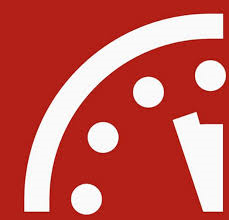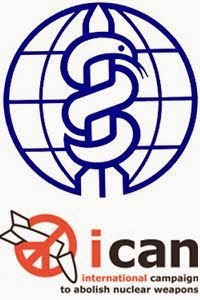It's hard to imagine... We've survived the Mayan Apocalypse and nearly fell over the fiscal cliff!!! Phew! That being said, the greatest threat to the survival of humankind still hangs over us like a Sword of Damocles, and this one doesn't come with a target date (although military planners most likely have plenty of potential targets in mind).
As we move into another New Year the money is flowing (like a fire hose at a three alarm fire) into the U.S. nuclear weapons complex. And of course, the rest of the world is taking notice and following our lead. Here are the most notable projects that come to mind.
 The Y-12 Facility's $6.5 billion Uranium Processing Facility is moving ahead, although it recently experienced a minor glitch. Despite years of design work officials recently admitted that the facility will have to be redesigned because all the equipment needed to process bomb-grade uranium and conduct other related activities won't fit into the existing design... ooooops! Y-12 has already built a brand new Highly Enriched Uranium Materials Facility for storage of bomb grade uranium. The HEUMF cost over a half billion dollars.
The Y-12 Facility's $6.5 billion Uranium Processing Facility is moving ahead, although it recently experienced a minor glitch. Despite years of design work officials recently admitted that the facility will have to be redesigned because all the equipment needed to process bomb-grade uranium and conduct other related activities won't fit into the existing design... ooooops! Y-12 has already built a brand new Highly Enriched Uranium Materials Facility for storage of bomb grade uranium. The HEUMF cost over a half billion dollars.Construction of a huge new $673 million nuclear weapons manufacturing facility in Kansas City, Missouri is well underway. The new facility will replace the existing Kansas City Bomb Plant, and will construct approximately 85 percent of the non-nuclear parts for nuclear weapons.
National Nuclear Security Administration has already spent nearly a half a billion dollars on a new Chemistry and Metallurgy Research Replacement (CMRR) facility at Los Alamos National Laboratories. The $4 to 12 billion facility is intended to produce plutonium pits for nuclear weapons. Quite ironically, the governments highest level scientific experts (the JASONS) have concluded that the pits in the nation's existing nuclear warheads have a lifetime of at least a hundred years.
The U.S. has continued to "refurbish" the W-76 nuclear warhead deployed on Trident II D-5 submarine launched ballistic missiles through the Life Extension Program that will cost close to $2 billion. The B-61 gravity (nuclear) bomb, on the other hand, is estimated to cost $10 billion to upgrade.
The 450 Minuteman III Intercontinental Ballistic Missiles, deployed in underground silos around the country and ready to launch on warning, have been completely rebuilt. As one analyst said, "they are basically new missiles except for the shell." The modernization of Minuteman III has cost more than $7 billion over the past decade.
The Navy is full steam ahead with plans to build twelve new ballistic missile submarines to replace the current OHIO class submarines. With nearly $2 billion in contracts having just been awarded for ongoing design and development work, the project is well on its way toward the nearly $100 billion that it will cost to build the new subs.
Of course the government has been working hard (and spending even more money) conducting tests to ensure the capabilities of the nuclear arsenal - including "sub critical" explosive testing of Plutonium and test firings of Minuteman III and Trident II D-5 missiles.
There is much, much more, but you get the idea by now. While President Obama and Congress were fighting over the "fiscal cliff" the companies that manufacture, modernize and maintain nuclear weapons and their delivery vehicles and the companies that finance them were toasting a New Year bursting with the promise of profits.
Meanwhile, runaway spending on weapons that threaten humanity with extinction is stealing from human needs while encouraging other nations to either modernize and expand their arsenals or, in the case of non-nuclear nations, to develop their own nuclear weapons.
The challenges in the coming year to those working to abolish nuclear weapons are enormous!!! In the U.S. we are still speaking in Cold War terms like "deterrence", while not questioning the rationale for replacing nuclear weapons systems (like Trident) with essentially identical systems that were originally designed in the context of the Cold War struggle to achieve nuclear dominance over the Soviet Union in the dangerous game of Mutually Assurred Destruction (MAD).
In the coming year we need to be at least as strategic in our thinking, planning and execution as those who plan and prepare for the real apocalypse.
There has been no public debate regarding an archaic "deterrence" doctrine, while "deterrence" is still being used to justify almost every aspect of the U.S. nuclear arsenal. It is certainly time to engage the debate and counter this outdated military doctrine.
 We also need to know our adversaries in this struggle. We need to bring serious public pressure to bear on the companies that manufacture, modernize and maintain nuclear weapons and their delivery vehicles and the companies that finance them. The groundbreaking report Don't Bank on the Bomb, from the International campaign to abolish nuclear weapons (ICAN), is the first major global report that identifies not only the companies doing nuclear weapons work, but also the "more than 300 banks, insurance companies, pension funds and asset managers from 30 countries that invest significantly in 20 major nuclear weapons producers."
We also need to know our adversaries in this struggle. We need to bring serious public pressure to bear on the companies that manufacture, modernize and maintain nuclear weapons and their delivery vehicles and the companies that finance them. The groundbreaking report Don't Bank on the Bomb, from the International campaign to abolish nuclear weapons (ICAN), is the first major global report that identifies not only the companies doing nuclear weapons work, but also the "more than 300 banks, insurance companies, pension funds and asset managers from 30 countries that invest significantly in 20 major nuclear weapons producers."If we can get the kind of coverage in the mainstream press (in the U.S) that we have seen in the United Kingdom in the debate over Trident in the UK, that will be a major success. That should be our goal - to "mainstream" the discussion about nuclear disarmament and the role (and responsibilities) of the U.S. in the process, and bring serious political pressure to bear.
Global nuclear disarmament is obviously a very long-term goal. The work, however, must begin now, and the coming year is going to be critical to setting a direction for the future. All of us engaged in nuclear abolition efforts need to be supportive of one another's efforts in order to generate a critical mass (no pun intended) that can have an impact on policy makers.
Perhaps a good mantra for the New Year would be "Nuclear Disarmament Begins at Home".
Peace,
Leonard












No comments:
Post a Comment